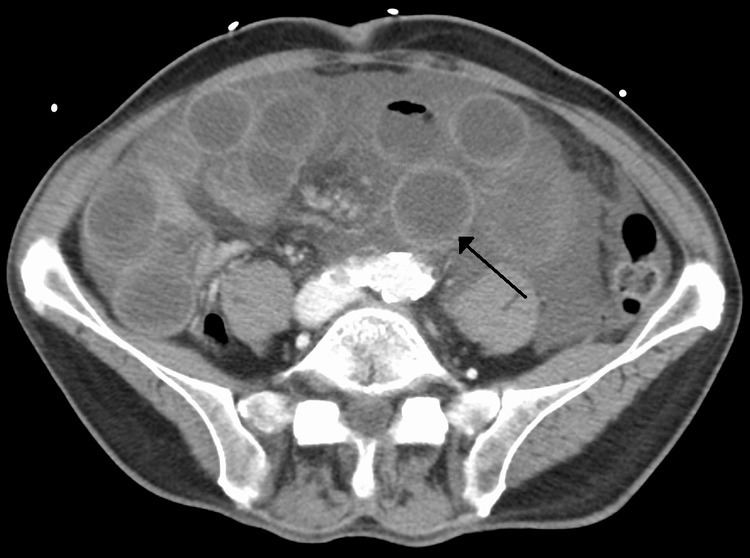Specialty gastroenterology ICD-9-CM 557.9 MedlinePlus 001156 | ICD-10 K55.9 DiseasesDB 29034 | |
 | ||
Synonyms mesenteric ischaemia, mesenteric vascular disease | ||
Mesenteric ischemia is a medical condition in which injury of the small intestine occurs due to not enough blood supply. It can come on suddenly, known as acute mesenteric ischemia, or gradually, known as chronic mesenteric ischemia. Acute disease often presents with sudden severe pain. Symptoms may come on more slowly in those with acute on chronic disease. Signs and symptoms of chronic disease include abdominal pain after eating, unintentional weight loss, vomiting, and being afraid of eating.
Contents
- Signs and symptoms
- Clinical findings
- Diagnostic heuristics
- Diagnosis
- Blood tests
- During endoscopy
- Plain X ray
- Computed tomography
- Angiography
- Treatment
- Prognosis
- History
- References
Risk factors include atrial fibrillation, heart failure, chronic renal failure, being prone to forming blood clots, and previous myocardial infarction. There are four mechanisms by which poor blood flow occurs: a blood clot from elsewhere getting lodged in an artery, a new blood clot forming in an artery, a blood clot forming in the mesenteric vein, and insufficient blood flow due to low blood pressure or spasms of arteries. Chronic disease is a risk factor for acute disease. The best method of diagnosis is angiography, with computer tomography (CT) being used when that is not available.
Treatment of acute ischemia may include stenting or medications to break down the clot provided at the site of obstruction by interventional radiology. Open surgery may also be used to remove or bypass the obstruction and may be required to remove any intestines that may have died. If not rapidly treated outcomes are often poor. Among those affected even with treatment the risk of death is 70% to 90%. In those with chronic disease bypass surgery is the treatment of choice. Those who have thrombosis of the vein may be treated with anticoagulation such as heparin and warfarin, with surgery used if they do not improve.
Acute mesenteric ischemia affects about five per hundred thousand people per year in the developed world. Chronic mesenteric ischemia affects about one per hundred thousand people. Most people affected are over 60 years old. Rates are about equal in males and females of the same age. Mesenteric ischemia was first described in 1895.
Signs and symptoms
Three progressive phases of mesenteric ischemia have been described:
Clinical findings
Symptoms of mesenteric ischemia vary and can be acute (especially if embolic), subacute, or chronic.
Case series report prevalence of clinical findings and provide the best available, yet biased, estimate of the sensitivity of clinical findings. In a series of 58 patients with mesenteric ischemia due to mixed causes:
Diagnostic heuristics
In the absence of adequate quantitative studies to guide diagnosis, various heuristics help guide diagnosis:
Diagnosis
It is difficult to diagnose mesenteric ischemia early. One must also differentiate ischemic colitis, which often resolves on its own, from the more immediately life-threatening condition of acute mesenteric ischemia of the small bowel.
Blood tests
In a series of 58 patients with mesenteric ischemia due to mixed causes:
During endoscopy
A number of devices have been used to assess the sufficiency of oxygen delivery to the colon. The earliest devices were based on tonometry, and required time to equilibrate and estimate the pHi, roughly an estimate of local CO2 levels. The first device approved by the U.S. FDA (in 2004) used visible light spectroscopy to analyze capillary oxygen levels. Use during aortic aneurysm repair detected when colon oxygen levels fell below sustainable levels, allowing real-time repair. In several studies, specificity has been 83% for chronic mesenteric ischemia and 90% or higher for acute colonic ischemia, with a sensitivity of 71%-92%. This device must be placed using endoscopy, however.
Plain X-ray
Plain X-rays are often normal or show non-specific findings.
Computed tomography
Computed tomography (CT scan) is often used. The accuracy of the CT scan depends on whether a small bowel obstruction (SBO) is present.
SBO absent
SBO present
Findings on CT scan include:
Angiography
As the cause of the ischemia can be due to embolic or thrombotic occlusion of the mesenteric vessels or nonocclusive ichemia, the best way to differentiate between the etiologies is through the use of mesenteric angiography. Though it has serious risks, angiography provides the possibility of direct infusion of vasodilators in the setting of nonocclusive ischemia.
Treatment
NG tube decompression, angiogram for diagnosis and treatment, heparin anticoagulation. Papaverine to decrease arterial vasospasm.
"Surgical revascularisation remains the treatment of choice for mesenteric ischaemia, but thrombolytic medical treatment and vascular interventional radiological techniques have a growing role".
If the ischemia has progressed to the point that the affected intestinal segments are not savable, a bowel resection of those segments is called for. Often, obviously dead segments are removed at the first operation, and a second-look operation is planned to assess segments that are borderline that may be savable after revascularization.
Prognosis
The prognosis depends on prompt diagnosis (less than 12–24 hours and before gangrene) and the underlying cause:
In the case of prompt diagnosis and therapy, acute mesenteric ischemia can be reversible.
History
Acute mesenteric ischemia was first described in 1895 while chronic disease was first described in the 1940s. Chronic disease was initially known as angina abdominis.
